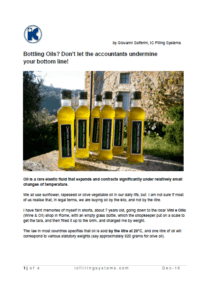Bottling Oils? Don't let the accountants undermine your bottom line.
How to save $1,500,000 dollars and avoid bean counters and accountants undermining your bottom line if you are bottling oils.
Written by IC Filling Systems Managing Director Giovanni Solferini.
Oil is a rare elastic fluid that expands and contracts significantly under relatively small changes of temperature.
We all use sunflower, rapeseed or olive vegetable oil in our daily life, but I am not sure if most of us realise that, in legal terms, we are buying oil by the kilo, and not by the litre.
I have faint memories of myself in shorts, about 7 years old, going down to the local Vini e Olio (Wine & Oil) shop in Rome, with an empty glass bottle, which the shopkeeper put on a scale to get the tara, and then filled it up to the brim, and charged me by weight.
The law in most countries specifies that oil is sold by the litre at 20°C, and one litre of oil will correspond to various statutory weights (say approximately 920 grams for olive oil).
So, what does that mean for me as a bottler of vegetable oil? I can hear you say.
It means a lot for your bottom line, I say.
 Faced with these statutory requirements, most bottlers still use expensive and wasteful filling methods.
Faced with these statutory requirements, most bottlers still use expensive and wasteful filling methods.
The choices of filling currently adopted are as follows:
1) Use temperature control on the oil to make sure that you are filling oil at exactly 20°C. So, if it is winter and your oil is outside at 10°C or less, that means warming it up to 20°C via a heat exchanger - an expensive process.
2) If it is summer, same again, but reversed with a chiller hooked up to cool down the oil. Does it sound expensive? It is.
3) Alternatively, take an average temperature reading from your oil storage tanks, calculate the volume to dispense in proportion to the statutory requirements, and add 2-3% for good measure to the quantity dispensed.
All the three methods above are used in conjunction with gravity, low vacuum and piston volumetric filling of oils.
The net result is that to be on the safe side of the Trading Standards inspectors, most production managers add 2-4% to the quantity. So they are giving away up to 4% of their production.
Now if you take, say, just 3% of 20 million 1 litre bottles a year (like a large bottler in England that I did this exercise for) you give away a lot of money.
Take, for example, sunflower oil from China at the lowest bulk price of $ 500 per tonne. 3% of 20,000 tonnes is about $ 300,000.
$ 300,000 of giveaway year after year is a lot of dosh in any language, I think.
So I introduced them to the concept of weight filling, which is pretty straightforward.
The filling machine is fitted with a weight cell on each valve.
The weight filling machine does automatically what my old shop keeper used to do in Rome at the Vini e Olio all those years ago:
1. It takes the bottles, calculates the tara individually, and fills to the weight required.
2. The adjusted individual error is +/- 1 per cent, and the median ponderal error (a
measure used by Trading Standards inspectors) is zero.
3. Any underweight bottle is automatically discarded at the exit from the filler when it is weighed full for Q.A. purposes. This will be less than 1 in 10,000 bottles.
The weight filler does cost about 60% more (like for like) than a piston volumetric filler, but the difference pays itself off on average within less than a year.
So, I hear you say again, surely everybody is changing old style piston filling machines to weight fillers when filling oil?
Not so.
As I found out with that potential user, the financial guys often take over.
And, being bean counters, they often forgo a medium term profit for a lower cost of immediate capital investment.
So, duly, those specific bean counters decided to buy an older and basically obsolete technology because it was cheaper to buy.
Since then, 5 years have passed.
During this time, they could have saved their company 1.5 Million US Dollars! Put another way, that’s a saving of $5,679 every week of the year.
I also think that, deep in their heart, (as only non-technical bean counters do), they didn’t really believe it, and didn’t believe in their heart that any savings could materialise.
It seemed to me at the time a bit like building a new house without loft and wall insulation, and without solar panels on the roof, or a heat pump in the back garden.
Surely more expensive than building an old-fashioned house, but who would leave out those improvements nowadays?
So, remember this little story next time your financial director tries to sink one of your energy or other cost saving investment schemes that make sense financially to you.
And give them a copy of this article, and whisper the phrase “return on investment”.
Don’t let the bean counters undermine your Company’s bottom line!
Meantime, Cheers!
Giovanni

